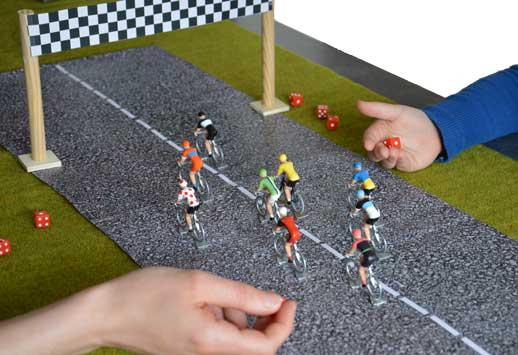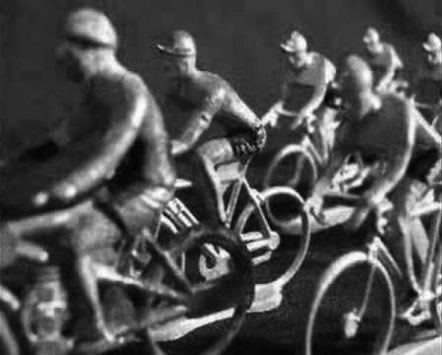No products
History of miniature cyclist figurines
Miniature cyclists were created in the 1930's. Especially in countries where cycling is some kind of a religion, as France, Belgium and Italy these miniature cyclists were extremely popular.
A long time before we had Playstation and expensive racing bikes, childs played with miniature cycling figures, a dice, a pen and a notebook. The more eyes you threw, the closer you came to the finish. The standings were noted down in the notebook. Sometimes the dice was replaced by marbles. Children were creative in making their own game board. This is how the young cycling fans were able to ride the race of their heroes and to compete with the friends.

In the 1980's the interest in miniature racing cyclists was completely disappeared. But from the year 2000 the interest in handcrafted, handpainted miniature cyclist figures was totally back. Young and old love the miniature cyclists! Wonderfull jerseys of today's cycling heroes and those of the past.
Today miniature cycling figures are seen as an exclusive gadget. Although, in a nostalgic day, the Peloton team created a maquette. And we have to admit, it's still very pleasant to play the old miniature racing cyclists game!
Thanks to Peloton you can compose your own cycling peloton with the cycling jerseys of the past and those of today. The Peloton miniature cyclists are wonderful collector items. They are also perfect to offer as a present to a cycling fan!


The early types of the bicycle before the development of today's common low bicycle - i.e. the walking machine in the 1820s, often referred to as a trolley, and especially the penny-farthing in the 1870s and 1880s - were characterized by the fact that the bicycle was not a utility vehicle, but was used as a sport and fun device. High cyclists were considered courageous gamblers and accordingly attracted a lot of attention with adventure tours since the 1870s. The American Thomas Stevens is said to have succeeded in making the first circumnavigation of the world on two wheels between 1884 and 1886.
In Germany, the Eimsbütteler Velocipeden Club was founded on April 17, 1869, the first cycling club in Altona/Elbe. Already on September 10th, during an industrial exhibition in the same year, bicycle fans organized a first race with participants from France, Denmark and England.
Soon public interest shifted from adventure rides, which were more like voyages of discovery than sports, to record rides, where individual racers had to cover a certain distance (such as the maximum distance in the British Isles from Cornwall to northern Scotland of 1400 km) in the shortest possible time. This allowed sceptical contemporaries to demonstrate the superiority of the bicycle over all other individual means of transport at the turn of the 20th century.
The world's first one-day race was held in Paris on 8 December 1867. About 100 participants gathered on the Avenue des Champs-Élysées and set off for the Château de Versailles some 23 km away.
The first cycling race contested by women was held in Bordeaux on 1 November 1868. The venue for the event was the Parc Bordelais. Four women completed a race on a 500-metre course.
The first road race is said to have taken place as early as 1865 in Amiens (France). Many of the races initiated at that time are still "classics" today, such as the "spring classics" Liege-Bastogne-Liège (since 1892), Paris-Roubaix (since 1896) or Milan-San Remo (since 1907). Since the first Summer Olympic Games in 1896, road and track cycling have been Olympic disciplines. A hundred years later, in 1996, mountain bike racing was added and in 2008 the BMX race was added.
Especially from the 1990s onwards, endurance races attracted increasing attention from the public, with a larger number of competing racers having to cover distances of almost always more than 500 km.
Finally, in 1903, the Tour de France was created as the first stage race, in which similar distances had to be covered as in endurance races - in this case, however, on several consecutive days. At that time, 2428 km were completed in six stages, the average speed of the winner was a remarkable 26 km/h.
In addition to road races, cycling events on the track, such as six-day races and standing races, were extremely popular even in the early days of cycling.
An important aspect of cycling is the fact that the first systematic sponsorship in modern sport was practised here: From the very beginning, all kinds of cycling were supported and influenced by bicycle companies, because it was an excellent way of illustrating the performance of the bicycle as a product in itself, which was often doubted at first, and later of the various makes in particular. As early as the 1910s, professional cyclists did not ride in national teams in the Tour de France, but rather, as is the case today, in company teams. This illustrates the completely different development than in decades of amateur sports like gymnastics, football or athletics.
In general, from the turn of the 20th century until the First World War, cycling is considered by historians to be perhaps the most important and popular spectator sport besides boxing.

